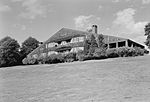Blithewold Mansion, Gardens and Arboretum
1895 establishments in Rhode IslandArboreta in Rhode IslandBotanical gardens in Rhode IslandBuildings and structures in Bristol, Rhode IslandHistoric house museums in Rhode Island ... and 5 more
Houses in Bristol County, Rhode IslandHouses on the National Register of Historic Places in Rhode IslandMuseums in Bristol County, Rhode IslandNational Register of Historic Places in Bristol County, Rhode IslandProtected areas of Bristol County, Rhode Island

The Blithewold Mansion, Gardens and Arboretum is an arboretum of 13 hectares (32 acres), located at 101 Ferry Road, Bristol, Rhode Island, midway between Newport and Providence, Rhode Island, on Bristol Harbor with views over Narragansett Bay. It includes a mansion, with a 4 hectares (9.9 acres) lawn and over 300 species of woody plants in its arboretum and gardens, including both native and exotic species. The Mansion and its grounds were established in the 1890s by Augustus and Bessie Van Wickle as their summer retreat. Augustus Van Wickle was from Hazleton, Pennsylvania, with a fortune in the coal-mining business and a donor of the Van Wickle Gates at Brown University.
Excerpt from the Wikipedia article Blithewold Mansion, Gardens and Arboretum (License: CC BY-SA 3.0, Authors, Images).Blithewold Mansion, Gardens and Arboretum
Ferry Road,
Geographical coordinates (GPS) Address Nearby Places Show on map
Geographical coordinates (GPS)
| Latitude | Longitude |
|---|---|
| N 41.654166666667 ° | E -71.266111111111 ° |
Address
Blithewold Mansion and Garden
Ferry Road
02809
Rhode Island, United States
Open on Google Maps








